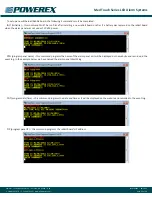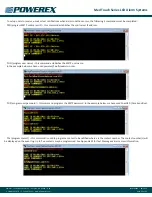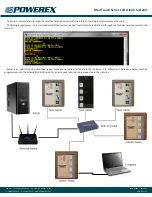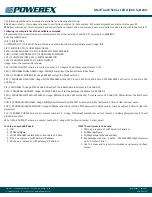
Med Touch Series LCD Alarm Systems
Powerex
•
150 Production Drive
•
Harrison, OH 45030
•
USA
P 1.888.769.7979
•
F 513.367.3125
•
www.powerexinc.com
IN597400AV
•
08/2016
Page 17 of 56
Alarm Operation
This section deals with the daily operational aspects of the alarm panel. After installation has been completed and the final user programming of the panel has been properly
configured, it is ready for operation.
Silencing the Alarm
Press the Silence button when the alarm is sounding and the alarm
will be silenced.
Repeater Delay
Area alarm modules are programmed with a Repeater Delay feature
which monitors only the Gas Module (Area) alarms. The Repeater
Delay has been factory programmed to make the alarm re-sound
every 10 (ten) minutes as long as the alarm condition exists.
NOTE:
The repeater delay may be re-programmed to a different
duration or turned-off (see programming page 25). Master remote
signal modules may be programmed by the user with the same
repeater delay feature (see programming page 25).
Testing the Alarm
Pressing and holding the Test button initiates a self-test of the alarm.
All LCD’s will illuminate for as long as the Test button is depressed. In
addition the buzzer will sound. If any LCD is faulty the circuit board
should be replaced. If the buzzer does not sound, it is faulty and the
circuit board should be replaced.
NOTE:
The alarms (both Area & Master) have a filter programmed
to ignore transient signals that are less than 0.7 seconds in duration.
Area Alarm Gas Modules
Monitor the status of the medical gas ‘areas’ of the facility. Gas
modules communicate with transducers and provide: 1) the pressure
readings of the gas on each gas display 2) the Normal LCD (green) or
Alarm Conditions LCD (red) on each gas display and 3) the emergency
instructions (programmed by the user).
If the pressure of one of the gases drops below the programmed
low limit setting, the following events take place simultaneously: 1)
the Normal LCD will be extinguished 2) the Pressure Low LCD (red)
will illuminate 3) an audible alarm will sound 4) the emergency
instructions will be displayed alternately with the pressure low (red)
alarm display if they have been programmed by the user.
If the pressure of one of the gases rises above the programmed
high limit setting, the following events take place simultaneously:
1) the Normal LCD will be extinguished 2) the Pressure High LCD
(red) will illuminate 3) an audible alarm will sound 4) the emergency
instructions will be displayed alternately with the pressure high (red)
alarm display if they have been programmed by the user.
Master Remote Signal (Dry Contacts)
Monitor the status of the sources of the medical gas distribution
system in communication with the remote equipment dry contacts
connected to it and provide the emergency instructions (programmed
by the user).
The remote signals (master) module displays (via green or red
indicators) the normal/abnormal status of the remote equipment
connected to the alarm. All alarm panels are pre-programmed upon
leaving the factory to monitor normally closed signals (per NFPA
99). In normal operation all active signals will be green. Whenever
an abnormal status signal is detected the corresponding green LCD
will be extinguished and the red LCD will illuminate. Simultaneously
an audible alarm will sound. Pressing the Silence button silences
the audible alarm (the Red LCD continues to be lit). Emergency
instructions will be displayed alternately with the signal point text if
they have been programmed by the user. The appropriate personnel
should be notified immediately of the alarm condition. When the
alarm condition has been rectified the Red LCD is automatically
extinguished and the Green LCD illuminates.
NOTE:
Master alarm signals shipped programmed to not repeat –
but may be re-programmed (see page 20) to repeat incorporating
the Repeater Delay feature.
Master Remote Signal (Transducer Inputs)
Monitor the status of the sources of the medical gas distribution
system in communication with the transducers connected to it (up
to 4) and provide the emergency instructions (programmed by the
user).
The standard display will appear and react just like the conventional
remote signal master dry contact displays that the industry is used
to (reference page 20), but a touch of the display will change the
display (for 30 seconds) to look and react just like the conventional
area alarm gas display that the industry is used to (reference page
20). The advantages of using transducers over pressure switches are;
•
Digital display of actual gas pressure
•
Greater accuracy / repeatability
•
Improved safety (an alarm condition notification is created
immediately should a transducer fail)
•
Easy / fast push button re-setting of alarm set points
•
Lower cost (in most cases)
Master 4 – 20 mA Remote Signal
Monitors the status of a source of the medical gas distribution
system (i.e. – liquid level of bulk oxygen) in communication with
one 4 – 20 mA signal input generate and display a bar graph with
user defined units, provide high & low alarms with user defined set-
points and provide the emergency instructions (programmed by the
user). Other applications may include monitoring flow rates, levels,
concentrations, humidity, etc.
Ethernet Module
This optional module may be added to any alarm panel. It will
provide the following features:
•
Webserver – allows a remote user access to the alarm’s web
page – viewing a graphic image of the alarm with all signal
conditions, pressure and event / history log information
















































